What is the SECI model?
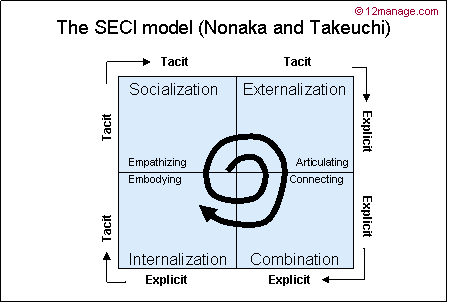
Ikujiro Nonaka and Hirotaka Takeuchi propose a model of the knowledge creating
process to understand the dynamic nature of knowledge creation, and to manage
such a process effectively: the SECI model. It consist of 3 elements:
- SECI
- Ba
- Knowledge Assets
These 3 elements interact with each other organically and dynamically.
The knowledge assets of an organization are mobilized and shared in 'Ba' whereas
the tacit knowledge held by individuals is converted and amplified by the
spiral of knowledge through:
- Socialization
- Externalization
- Combination
- Internalization
The three elements should be integrated under clear leadership so that
the organization can create knowledge continuously and dynamically: it must
become a discipline for organizational members.
SECI
The creation of knowledge is a continuous process of dynamic interactions
between tacit and explicit knowledge. The four modes of knowledge conversion
interact in the spiral of knowledge creation. The spiral becomes larger in
scale as it moves up through organizational levels, and can trigger new spirals
of knowledge creation.
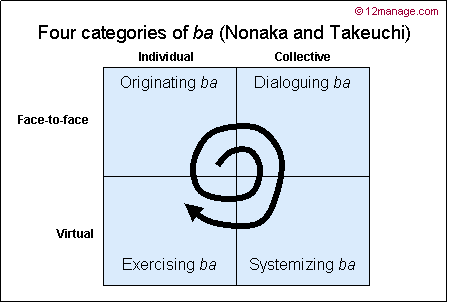
Socialization. Sharing tacit knowledge through face-to-face communication
or shared experience. An example is an apprenticeship.
Externalization. Developing concepts, which embed the combined tacit
knowledge. And which enable its communication.
Combination. Combination of various elements of explicit knowledge:
building a prototype is an example.
Internalization. Closely linked to learning by doing, the explicit
knowledge becomes part of the individual's knowledge base (e.g. mental model)
and becomes an asset for the organization.
Ba
This difficult concept (there is no exact translation of the word) can
be defined as a shared context in which knowledge is shared, created and utilized
through interaction.
The diagram illustrates the various types of Ba, each offering a context
for a specific step in the knowledge-creating process.
Examples of the categories, using Seven-Eleven (Japanese convenience shops):
- Originating Ba: the shop floor, it enables people to interact
with each other and with customers.
- Dialoguing Ba: the tacit knowledge of local employees is used
to create sales forecasts, in dialogue with each other.
- Systemizing Ba: the forecasts of sales are tested against the
sales results and are fed back to the local stores.
- Exercising Ba: using this information, and comparing it to reality,
staff improve their skills and ability to make the forecasts.
Knowledge assets
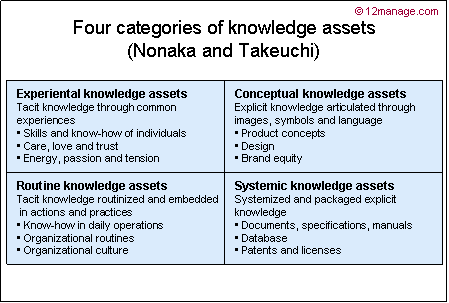
These are company-specific resources that are indispensable to create values
for the firm. They are the inputs, outputs, and moderating factors, of the
knowledge-creating process.
To effectively manage knowledge creation and exploitation, a company has
to 'map' its inventory of knowledge assets. Cataloguing is however not enough:
knowledge assets are dynamic; new knowledge assets can be created from existing
knowledge assets.
The role of leadership is illustrated in the next diagram:
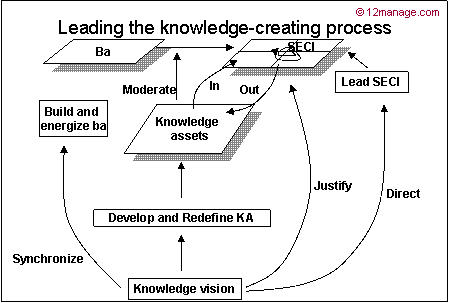
Origin of the SECI model. History
The model from Nonaka and Takeuchi is based on Polanyi's distinction between
tacit and explicit knowledge (1983) and provides an understanding of knowledge
creation and management from a Japanese business culture perspective.
Strengths of the SECI model. Benefits
- Appreciates the dynamic nature of knowledge and knowledge creation.
- Provides a framework for management of the relevant processes.
Limitations of the SECI model. Disadvantages
- It is based on a study of Japanese organizations, which heavily rely
on tacit knowledge: employees are often with a company for life.
- The linearity of the concept: can the spiral jump steps? Can it go counter-clockwise?
Book: Ikujiro Nonaka,
Hirotaka Takeuchi - The Knowledge-Creating Company
|
Forum discussions about the SECI model.

|
SECI for Integration Between ETOM and KM System
The SECI model has been implemented in many industries.
The Telecom industry has eTOM as business process framework with critical knowledge in each level of processes.
A specific effort is need to i...
 7 |

|
History of Knowledge Management
I found that other models and concepts came after SECI model. Referring to history,
- "Since 1975, the knowledge management (KM) related developments have been the emerging subject in organizations"...
 5  1 comments |

|
Digital Learning Platform Based on SECI
I am setting up a digital learning platform for staff members of many different organisations about the dynamics of different generations and generations types in organisations. The platform is based ...
 4  3 comments |

|
Linking SECI Model to Innovation
I have some thoughts on how Knowledge Management and Innovation are linked... There are a number of models for implementing innovation. A simple model that I like involves 5 steps:
1. Idea Generation...
 4  2 comments |

|
SECI Software Tools?
Hi Everybody. I am looking for a software solution to support a SECI implementation.
Does anybody has a software product in mind? One based on SECI model?
Best regards......
 4  2 comments |
|
|
|
Courses about the SECI model.
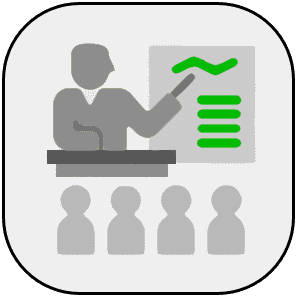
Beginners Course
|

Advanced Course
|

Course for Experts
|
|
|
|
The best, top-rated topics about the SECI model. Here you will find the most valuable ideas and practical suggestions.
|
|
|
Advanced insights about the SECI model. Here you will find professional advices by experts.

Consultancy Tips
|

Teaching Tips
|

Practical Implementation Tips
|
|
|

|
Barriers that Hinder Effective Knowledge Sharing Effective Knowledge Sharing, Pitfalls to Avoid, Knowledge Management Implementation
According to Chris Collison, there are seven common barriers or syndromes that hinder effective knowledge sharing and se...
|

|
9 Major Definitions of Knowledge Management Knowledge Management
- KM is the "process of collecting, organizing, classifying and disseminating information throughout an organization, so...
|

|
How to Identify and Map Knowledge Knowledge Identification, Knowledge Capturing, Knowledge Storage
In his article “Knowledge Mapping: The Essentials for Success”, Wesley Vestal provides following six tips to identify an...
|

|
The N-Form Organization (Hedlund) Alternate KM Framework
Gunnar Hedlund of the Stockholm School of Economics introduced the notion of the N-Form corporation in 1994. He proposed...
|

|
Critical Activities to Build a Learning Organization Implementing Organizational Learning, Best Practices
Learning organizations are distinguished because they are undertaking certain activities to foster the internal learning...
|

|
Capturing Learned Lessons How to Capture Organizational Learning? Best Practices
Knowledge from bad and good experiences will lead you and your organization to better future performance. You can improv...
|

|
Knowledge Management Scope Knowledge Management, Level of Know-how
Research by Deishin Lee (HBS) and Eric Van den Steen (MIT) shows that recording mediocre know-how can actually be counte...
|

|
Three Pillars of Knowledge Management (WiiG) Alternate KM Framework
Karl Wiig is one of the pioneers in the field of Knowledge Management and was among the first to publish a series of tex...
|

|
Components of Learning Agility Organizational Agility, Organizational Learning, Knowledge Management
One of the critical factors for achieving organizational agility is learning agility, which refers to the ability and ea...
|

|
Positive Effects of Age Diversity on Company Productivity and (Tacit) Knowledge Sharing Tacit Knowledge Transfer, Workforce Productivity, Incentive Management
Backes-Gellner and Veen (2013) outlined the main advantages of having a diverse workforce within a company. The followin...
|

|
Knowledge Management Focal Point Knowledge Management Focus
Research by Deishin Lee (HBS) and Eric Van den Steen (MIT) shows that information about successes is typically more usef...
|
|
|
|
Various sources of information regarding the SECI model. Here you will find powerpoints, videos, news, etc. to use in your own lectures and workshops.

|
Revisiting Knowledge Management Integrating Knower with the Knowledge Processes
Very good paper by Madhukar Shukla gives historic overview of KM, 3 dimensions of KM and future directions of KM....
|

|
How Businesses can Use Information Technology (IT) in Strategic Ways Strategic Management, Information Technology
This presentation looks at Information Technology from a strategic point of view. In other words, it discusses in what w...
|

|
People and Latent Knowledge in Organizational Learning Knowledge Creation, Explicit Knowledge, Tacit Knowledge
Knowledge management theory has struggled with the concept of knowledge creation. Since the seminal article of Nonaka in...
|

|
How to Improve Knowledge Sharing in Knowledge-intensive Organizations Knowledge Management, Knowledge Sharing Motivation, Knowledge Sharing Platform. Tacit Knowledge
This presentation elaborates on the concept of knowledge sharing, thereby focusin on a knowledge-intensive organization ...
|

|
Introduction to Knowledge Management: Foundation Principles and Building Concepts Knowledge Management, Knowledge Sharing, Learning Organization
1. What is Knowledge?
1. What is Knowledge Management? Definition
2. Knowledge Foundation Principles and Building Conc...
|

|
Knowledge Transfer and Knowledge Sharing Knowledge Management, Knowledge Sharing, Knowledge Transfer
Preentation that is an introduction into the concept of Knowledge Transfer, including its fundamentals, strategies, guid...
|

|
Overview of Existing Types of Knowledge Knowledge Management, Knowledge Types, Tacit, Implicit, Explicit, Declarative, Procedural Knowledge
This presentation provides an overview of the different types of knowledge that exist. The presentation includes the fol...
|

|
Knowledge Management Systems Architecture Knowledge Management, Knowledge Creation, Knowledge Systems, Knowledge Architecture
This presentation is about knowledge development and management, including the following sections:
1. Overview
2. Know...
|

|
How to Integrate Internal Organizational Knowledge with External Online Communities Knowledge Management, Knowledge Creation, Knowledge Sharing, Interaction, Knowledge in Organizations
Due to many online and web-based technological developments in today´s digital economy, sharing knowledge in online comm...
|

|
Leveraging Cognition for Competitive Advantage:A Knowledge-Based Strategy Process Knowledge-intensive firms
Article by Senthil K. Muthusamy and Ramaraj Palanisamy. One of the central bases for achieving competitive advantage is ...
|

|
Discovering Knowledge Management Forces Healthcare
This paper by Khalid Samara is an ongoing research in the area of knowledge management (KM) and evidence-based practice ...
|

|
Introduction and Summary of SECI Initial Understanding of SECI. Start of workshop/training
Knowledge Management
Is utilizing tacit (the unseen huge part of the iceberg), as well as explicit (the tip of the iceb...
|

|
Knowledge Creation: The SECI Model Knowledge Management, Knowledge Creation
Presentation about the SECI model of Nonaka and Takeuchi (1996), a model about knowledge creation. The model is based on...
|

|
Knowledge Sharing and Organizational Learning through Communities of Practices Knowledge Sharing, Organizational Learning, Communities of Practices, Special Interest Groups
Knowledge management in Communities of Practice (CoPs)
This presentation is about organizational learning and knowledge...
|

|
SECI Model Diagrams Knowledge Management
Download and edit these 12manage PowerPoint graphics for limited personal, educational and business use.
Republishing i...
|

|
Knowledge Transfer in the E-world Knowledge Management, Knowledge Transfer, Internet, Intranet, E-Business, CRM
This is a presentation about Knowledge Transfer (KT), specifically focused on KT in the e-world. The presentation consis...
|

|
3 Pillars of KM Knowledge Management
Three Pillars of Knowledge Management (Wiig)....
|

|
N-Form Organization Knowledge Management
The Dynamics of Knowledge Management in an N-Form Organization....
|
|
|
|
Useful tools regarding the SECI model.

News
|

Videos
|

Presentations
|
| |

Books
|

Academic
|

More
|
|
|
|
Compare with the SECI model:
Bridging Epistemologies
| Organizational Learning
| Organizational
Memory | Action
Learning |
Knowledge Management
(Collison & Parcell)
Return to Management Hub: Knowledge & Intangibles | Leadership
More Management Methods, Models and Theory
|
|
|















